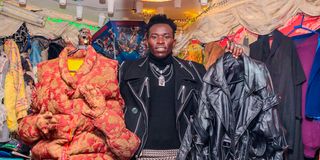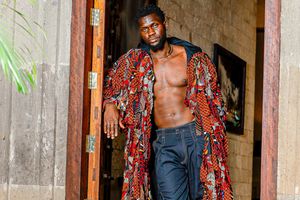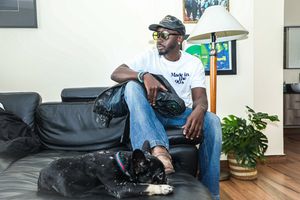
Fashion designer and stylist Morgan Azedy poses for a picture with some of his designs at Tassia Estate in Nairobi on February 11, 2025.
Morgan Azedy, also known as Kenyan Raw, never thought he would end up on the glamorous catwalks of Berlin at age 25. Growing up in Kisumu and building his brand in Nairobi, a city where markets are full of colourful fabrics, Morgan always had an affinity for crazy fashion. His journey began when he completed a diploma in textiles at Ramogi Institute in Kisumu.
For Morgan, fashion is not just about creating beautiful garments, it’s about evoking emotions and leaving a lasting impression. He got inspired after watching top designers’ fashion events, which left him with a desire to have his designs seen on an international stage. He has worked with many artists including Nadia and Willy Paul.
On February 2024, Morgan caught the attention of Luku Store, owned by a DJ in Amsterdam named Fransis. He saw one of Morgan’s designs on Instagram captioned ‘Fashion designers are making waves in the industry.’
“They loved my work and decided to contact me. We exchanged numbers, and Fransis shared his idea. Later, I was honored with an invite to showcase my designs in the Berlin Fashion Week,” says Morgan.
This was Morgan’s first opportunity to step onto the international stage. It was a dream come true and put him in the spotlight.
“Luku store gave us Sh70,000 for materials to make the clothes, and they also facilitated my visa and flight fees to Berlin. I designed the outfits from scratch and bought the accessories, including a pair of boots which cost Sh25,000,” Morgan says.
He was amazed by the beautiful and elegant designs at the fashion event, which brought together designers from all over the world.
“I saw outfits made from sisal fiber and a seven-inch shoe for men, but what I admired most was a dress made in the shape of a human heart.”
As the only Kenyan designer there, Morgan felt incredibly proud of his work.
“I learned so much. As Kenyans, we still have a long way to go in fashion. I realised that I need to do more research to expand my knowledge. I made connections with other designers.”
Among the collections Morgan presented was an Opium Streets Wear, which is Gothic-inspired and made from leather. From his 15 leather pieces, he sold six during the show.
“One of the pieces I sold was a half leather jacket, which went for around Sh16,000, while the maxi skirt I sold at Sh17,000. The cargo pants went for Sh25,000.”
Morgan reveres the work of Alexander McQueen and Nigel Xavier who are both fashion designers known for their innovative and risqué designs.
“Good artists copy, great artists steal.” Morgan quotes this statement from Pablo Picasso, suggesting that while all artists take inspiration from existing works, the most innovative ones transform these influences into something unique.
“I started to do fashion five years ago, and this is where I learned about textile, fashion and design. I chose to create more street-look outfits because many fashion designers are producing the same items. They all look alike,” he says.
Morgan describes his style as Urban Streetwear, tailored to different seasons and weather conditions. He is keen to use raw materials from Kenya.
“I am unique and I combine street wear with fashion, which allows me to bring crazy ideas that are unique and playful,” he explains. “I use all kinds of fabrics, including cotton, polyester, and wool.
Despite his success, Morgan has faced challenges familiar to many designers, including limited capital, sourcing quality materials, and battling perceptions of fashion’s importance. Yet these obstacles have fueled his determination to elevate Kenya’s fashion scene.
His store is located in a single room in Tassia, Embakasi East, just off Outerring Road. It is decorated with pictures of his designs and a collection of his finished works, including the jacket and boots he wore during the spotlight showcase in Berlin. Inside the store is a collection of fancy shoes that he hires out during photoshoot sessions. He also has a collection of jewellery.
For his complex designs, he uses machines like Juki and Singer.
“I bought the Juki machine at Sh65,000 and the Singer machine at Sh15,000” says Morgan.
His understanding of sustainable fashion goes beyond mere buzzwords; it is a core principle that guides every aspect of his design process.
“I collect discarded fabrics from factories, from tailors, and individuals and put them together to create outfits. For example, if someone throws away old bed sheets, old jackets, or blankets. I take them and wash them properly, then I use them in my collections.”
Through his innovative designs and commitment to sustainability, Morgan is not just creating clothing; he is crafting a new narrative for African fashion. One where creativity and environmental responsibility go hand in hand, where waste becomes wearable art, and where the boundaries between street style and high fashion blur into something entirely new. As a high-fashion model, he dresses in his designs to inspire respect and appreciation from others.
“After showcasing at Berlin Fashion Week, I aim to cement my status as an international sensation,” Morgan concludes.






